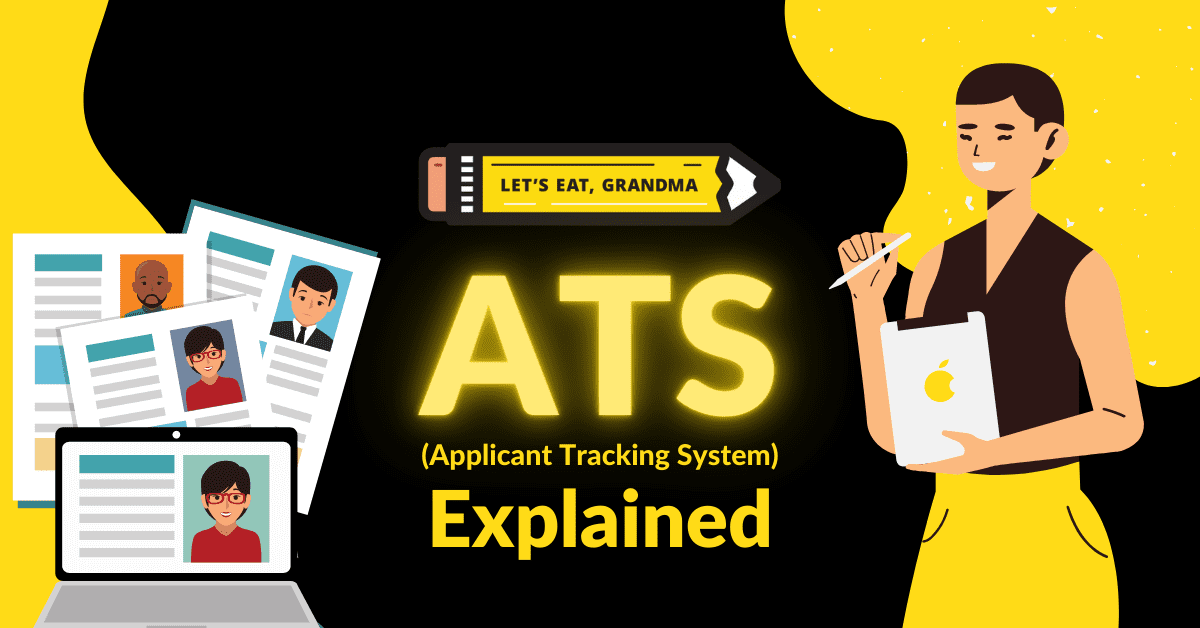Resume Screening Software? Not Exactly: Here’s How Applicant Tracking Systems (ATS) Work

The Applicant Tracking System (ATS) has become the bogeyman of the job search. But an ATS isn’t so much a piece of evil resume screening software as simply a database. Read on to learn how it actually impacts your chances and how you should optimize your resume to get hired.
By: Grace Mitchell | Contributor for Let’s Eat, Grandma
If you’ve taken in any media about job hunting in the past decade, you’ve probably heard folks mention the Applicant Tracking System, or ATS. What exactly is an ATS, though, and what do you really need to know about this so-called resume screening software to be successful in your job search?
The idea of preparing an ATS-ready resume can seem intimidating to the average job searcher, especially if you’re already struggling to keep up with emerging technology. We want you to feel empowered to approach the ATS not as a barrier, but as a reason to optimize your resume to the job you’re applying to — which you need to be doing to get hired anyway!
Tired of not landing interviews?
Get our free 3-step guide to writing better resume bullet points, featuring 70 ideas for metrics you can use!
What is an Applicant Tracking System? (It’s Not Just Resume Screening Software.)

Recruiters use resume screening software to sort, manage, and rank candidates for jobs. Photo by Surface on Unsplash
An ATS is essentially a database that helps hiring professionals sort through candidates for the jobs they’re hiring for. When you apply for a job through an online application for most major companies, it’s likely that your documents and application form responses are entered into an applicant profile in an ATS. In fact, 99% of Fortune 500 companies use one.
However, a particularly small company might not. And if you’re applying via email or through your network, you might not have your application go into an ATS.
There are many different Applicant Tracking Systems, and they don’t all work exactly the same way. However, some common features include allowing recruiters and hiring managers to filter or search for candidates by important keywords, rank candidates compared to the job description, and, of course, simply view all applications all in one place.
For example, if a job description emphasizes that a candidate must be proficient in Photoshop, the hiring manager can input “photoshop” as a keyword. This will focus their attention on candidates who mention this skill in their resume. They can even have the system rank candidates based on how many times they mention the skill in their resume.
The recruiter will still see resumes that don’t match their keyword inputs if they choose to. But if you want to make sure your resume gets a thorough glance, it’s important to include what they’re looking for.
So How Does the ATS Affect Me?

Have no fear! Resume screening software does not involve a robot reading your resume. Photo by Andrea De Santis on Unsplash
Since most companies use an Applicant Tracking System to receive and organize applications and help them screen candidates, it’s important to:
- Make your resume design ATS-friendly
- Integrate the main keywords from the job description that a recruiter would search for.
This isn’t nearly as scary as it may sound, though, because, as recruiters themselves explain, a person will still essentially always be able to see your resume.
There’s a common misconception that an ATS is simply a piece of resume screening software whose sole purpose is to reject resumes before a human sees them and that’s, well… not true. That stat you might have seen about 75% of resumes being rejected before a human sees them has been solidly debunked as a myth.
Virtually the only time your application might be “auto-rejected” by an ATS before a person is able to view it is if you answer incorrectly on a “knock-out question” that the recruiting team decided to use on the application form or with a chatbot. These are those incredibly basic application questions like “Are you legally authorized to work in this country?”
Plus, the keywords you need to integrate are words that recruiters will look for as they read your resume anyway. So integrating keywords and using a clean, easy-to-read design are important whether your resume will go into an ATS or not.
An ATS-friendly resume avoids fonts, formats, and images that could throw the system off. While systems vary somewhat in how they parse text from resumes (and they’ll usually pull from the application form that you’ll have a chance to manually correct), there are some general best practices.
For one thing, your resume should always be saved as either a Word or PDF document with standard resume headings. Calling your Summary of Qualifications something like “My Career Journey” may cause the system to label the section incorrectly. Sticking with the classic labels makes reading your resume easier for recruiters to read as well.
You should also avoid including photos, graphics, charts, or any other images in your resume, as these can be difficult for both the recruiter and the system to read. Any text contained in an image will not be parsed by an ATS.
If you’re not sure if your resume will be ATS-friendly, try converting it to a plain text document. A document that’s still readable as plain text should be no problem for the employer’s ATS.
NOTE: Do not submit your resume as that plain text file though! Use Word or PDF, and follow any instructions in the job description.
How Do I Know What Keywords to Use?

Hiring managers will use the job description to calibrate their ATS, so you can use it to optimize your resume. Photo by Kaleidico on Unsplash
We’ve mentioned a few times that recruiters sometimes use their ATS to look for resumes with specific keywords related to the job description. So how do you identify which keywords to use?
Luckily, you have the key right in front of you: The job description. Try printing it out and highlighting the words you see more than once, as well as the terms used under headings like “the ideal candidate must” or “required.” The hiring manager has indicated that these are the most valuable job skills, so it’s important to include them in your resume.
You can also run the job description through a word cloud generator if you’re more of a visual person than a numbers person. Skills used most often will show up in larger fonts on your word cloud, so you know to focus on these skill words in your resume.
(Remember, though, to keep in mind that not every keyword will be large in a word cloud and not every large word will be a keyword. ”Experience” and “required” are going to be large but clearly don’t need to be in your resume.)
While resume keywords are important, it’s also possible to overdo them. In general, you should be looking for the top 5-7 terms from the job descriptions, including both abbreviations and written-out terms. If the job description mentions SEO or Search Engine Optimization a few times, it’s good to include both terms since you have no way of knowing which will be the keyword the recruiter searches for, and not all Applicant Tracking Systems can find related words to the search term.
Now that you know a bit about what recruiters use an ATS to look for, it may be tempting to “cheat” the system by including the term more times in white font. Don’t do it. Hiring managers are smarter than that, and when they figure out your scheme, they’ll be annoyed rather than impressed at your unethical behavior.
So How Do I “Beat” the ATS?
The ATS isn’t a scary robot determined to take your career aspirations away. It’s not a piece of resume screening software that’s “out to get you.” Any task an ATS completes is 100% based on the input of the recruiters who use them. Hiring teams can receive up to hundreds of applicants for each job posting, so an ATS simply makes it easier for them to filter through and find qualified applicants.
The steps you’ll be taking to optimize for ATS are good steps to take in writing your resume anyway. ATS optimization involves making the information on your resume clearly organized and relevant to the job you’re applying for. This will help convince the actual decision-makers and get you hired more quickly.
In other words, it’s not a matter of “beating” the ATS. It’s more like applying ATS operating principles to your application process. This lets you move on to the important work of making your resume content interesting to human readers.
So don’t be afraid of the “robots”— let them help you crush the application process!
Ready for more job search help?
Sign up for a free Senior Writer Resume Critique to see what's holding you back from landing interviews. One of our top professional resume writers will give you personalized feedback on the top 3 items you can improve based on our expert practices!
